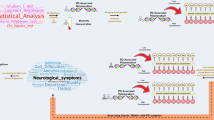Abstract
Parkinson’s disease (PD) is characterized by the loss of dopaminergic neurons and the presence of intracytoplasmic inclusions (Lewy bodies). Iron, which is elevated in the substantia nigra of PD patients, seems to be of pivotal importance, because of its capacity to enhance the amplification of reactive oxygen species. As iron enters and exits the brain via transport proteins in the blood-brain barrier (BBB), these proteins may represent candidates for a genetic susceptibility to PD. P-glycoprotein (P-gp) is one important efflux pump in the BBB. There is evidence that the function of P-gp is impaired in PD patients. In the current study we examined ten coding single nucleotide polymorphisms in the multidrug resistance gene 1 (MDR1) encoding P-gp to assess whether certain genotypes are associated with PD. However, genotyping of 300 PD patients and 302 healthy controls did not reveal a significant association between coding MDR1 gene polymorphisms and PD.



Similar content being viewed by others
Abbreviations
- BBB:
-
Blood-brain barrier
- HW:
-
Hardy–Weinberg
- MDR1:
-
Multidrug resistance gene 1
- PD:
-
Parkinson’s disease
- P-gp:
-
P-glycoprotein
- ROS:
-
Reactive oxygen species
- SN:
-
Substantia nigra
- SNP:
-
Single nucleotide polymorphism
- SNpc:
-
Substantia nigra pars compacta
- TCS:
-
Transcranial sonography
References
Bain LJ, LeBlanc GA (1996) Interaction of structurally diverse pesticides with the human MDR1 gene product P-glycoprotein. Toxicol Appl Pharmacol 141:288–298
Bartels AL, van Berckel BN, Lubberink M et al (2008a) Blood-brain barrier P-glycoprotein function is not impaired in early Parkinson’s disease. Parkinsonism Relat Disord 14:505–508
Bartels AL, Willemsen AT, Kortekaas R et al (2008b) Decreased blood-brain barrier P-glycoprotein function in the progression of Parkinson’s disease, PSP and MSA. J Neural Transm 115:1001–1009
Berg D (2006) Transcranial sonography in the early and differential diagnosis of Parkinson’s disease. J Neural Transm Suppl 70:249–254
Berg D, Becker G, Zeiler B et al (1999) Vulnerability of the nigrostriatal system as detected by transcranial ultrasound. Neurology 53:1026–1031
Berg D, Gerlach M, Youdim MB et al (2001a) Brain iron pathways and their relevance to Parkinson’s disease. J Neurochem 79:225–236
Berg D, Jabs B, Merschdorf U et al (2001b) Echogenicity of substantia nigra determined by transcranial ultrasound correlates with severity of parkinsonian symptoms induced by neuroleptic therapy. Biol Psychiatry 50:463–467
Berg D, Roggendorf W, Schroder U et al (2002) Echogenicity of the substantia nigra: association with increased iron content and marker for susceptibility to nigrostriatal injury. Arch Neurol 59:999–1005
Berg D, Hochstrasser H, Schweitzer KJ et al (2006) Disturbance of iron metabolism in Parkinson’s disease—ultrasonography as a biomarker. Neurotox Res 9:1–13
Borie C, Gasparini F, Verpillat P et al (2002) Association study between iron-related genes polymorphisms and Parkinson’s disease. J Neurol 249:801–804
Drozdzik M, Bialecka M, Mysliwiec K et al (2003) Polymorphism in the P-glycoprotein drug transporter MDR1 gene: a possible link between environmental and genetic factors in Parkinson’s disease. Pharmacogenetics 13:259–263
Excoffier L, Laval G, Schneider S (2005) Arlequin (version 3.0): an integrated software package for population genetics data analysis. Evol Bioinforma 1:47–50
Furuno T, Landi MT, Ceroni M et al (2002) Expression polymorphism of the blood-brain barrier component P-glycoprotein (MDR1) in relation to Parkinson’s disease. Pharmacogenetics 12:529–534
Jaccard J, Wan CK (1996) LISREL approaches to interaction effects in multiple regressions. Sage Publications, Thousand Oaks
Kortekaas R, Leenders KL, van Oostrom JC et al (2005) Blood-brain barrier dysfunction in parkinsonian midbrain in vivo. Ann Neurol 57:176–179
Kubo S, Hattori N, Mizuno Y (2006) Recessive Parkinson’s disease. Mov Disord 21:885–893
Lee CG, Tang K, Cheung YB et al (2004) MDR1, the blood-brain barrier transporter, is associated with Parkinson’s disease in ethnic Chinese. J Med Genet 41:e60
Litvan I, Halliday G, Hallett M et al (2007) The etiopathogenesis of Parkinson disease and suggestions for future research. Part I. J Neuropathol Exp Neurol 66:251–257
Moos T, Rosengren Nielsen T, Skjorringe T et al (2007) Iron trafficking inside the brain. J Neurochem 103:1730–1740
Ohtsuki S, Terasaki T (2007) Contribution of carrier-mediated transport systems to the blood-brain barrier as a supporting and protecting interface for the brain; importance for CNS drug discovery and development. Pharm Res 24:1745–1758
Raymond M, Rousset F (1995) GENEPOP (Version 1.2): population genetics software for exact tests and ecumenicism. J Hered 86:248–249
Rouault TA, Cooperman S (2006) Brain iron metabolism. Semin Pediatr Neurol 13:142–148
Rozen S, Skaletsky H (2000) Primer3 on the WWW for general users and for biologist programmers. In: Krawetz S, Misener S (eds) Bioinformatics methods and protocols: methods in molecular biology. Humana Press, Totowa
Tan EK, Skipper LM (2007) Pathogenic mutations in Parkinson disease. Hum Mutat 28:641–653
Tan EK, Chan DK, Ng PW et al (2005) Effect of MDR1 haplotype on risk of Parkinson disease. Arch Neurol 62:460–464
Acknowledgments
We are grateful to Claudia Schulte (Hertie Institute of Clinical Brain Research, University of Tuebingen) for technical assistance and for helpful discussions. This work was supported by the National Genome Research Network (NGFNplus).
Author information
Authors and Affiliations
Corresponding author
Rights and permissions
About this article
Cite this article
Funke, C., Soehn, A.S., Tomiuk, J. et al. Genetic analysis of coding SNPs in blood-brain barrier transporter MDR1 in European Parkinson’s disease patients. J Neural Transm 116, 443–450 (2009). https://doi.org/10.1007/s00702-009-0196-y
Received:
Accepted:
Published:
Issue Date:
DOI: https://doi.org/10.1007/s00702-009-0196-y



